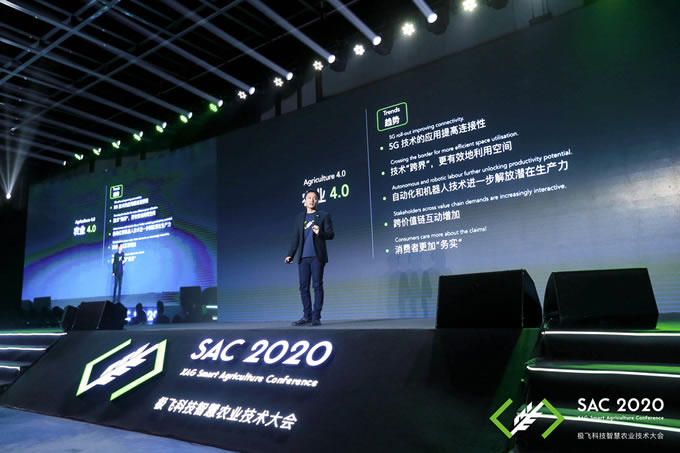From Sky to Ground, XAG Launches Farm Robots and Smart Agriculture Management System

Smart Agriculture Conference (SAC 2020), hosed by XAG, co-organised by Chinese National Precision Agricultural Aviation Centre and partnered with Alipay, was held in Beijing on December 19. The conference featured XAG's new product launch as well as a Smart Agriculture Report published by global strategy consultancy CLEAR. 400 global audiences, including agricultural experts, government officials, foreign diplomats and agri-business, had convened to share views on developing innovative human-centred strategy for a smart agriculture ecosystem.
Vincent Martin, FAO Representative China, argued that we must introduce technology to overhaul the traditional resource-intensive food system, to better resolve the pain points of sustainable agriculture development. "The transformation of agricultural production, rural economy and natural resource management requires the support of business innovation."
Foreseeing the Future of Agriculture 4.0
Justin Gong, Co-founder and Vice President of XAG, kicked off the conference by carefully elaborating the Smart Agriculture POV Report 2020. This report for the first time clarifies the definitions regarding digital agriculture, precision agriculture and smart agriculture.
- Digital agriculture is the technology that digitalises the planning, process and result of agricultural production, such as big data, AI, cloud computing and blockchain.
- Precision agriculture is the agricultural technology that harnesses information technology to achieve precision management, such as drone, robot and intelligent irrigation.
- Smart agriculture is the all-new agricultural production mode and ecosystem based on digital agriculture and precision agriculture. It creates new production scenarios to cope with population explosion, climate change and food crisis.
- Heralding the advent of agriculture 4.0, the report also identifies the biggest emerging opportunities and delivers strategies along the Smart Agriculture Roadmap. The objective is to sustainably feed the populated world with high-quality, nutritious food.
- There are five important emerging trends set to radically reshape the future of agriculture, including 5G revolution, robotic labour, technology cross-border, disintermediated supply chain and increasing demand for transparency.
- Digitalisation along with blockchain technology will be deployed to enhance the visibility, transparency and traceability of the supply chain.
- Information technology, artificial intelligence and biotechnology are three fundamental variables that enormously affect agriculture 4.0.
- To unleash the potential of smart agriculture, manufactures need to evolve beyond a purely 'engineering mindset' and take a human-centred approach.
- Smart agriculture propositions leverage mobile communication and deploy data analytics to help smallholders secure and management finance with ease.
XAG is one of the key participants to fulfil the vision of smart agriculture. Following the Smart Agriculture Roadmap, XAG has actively united data & information, tech-empowered tools and precision management approach as one integrated solution to optimise workforce and solve farmers' needs.
More Than Drone, Towards A Smart Agriculture Ecosystem
To establish an integrated smart agricultural system, XAG has released R80 Agricultural Utility Vehicle (XAUV™), AutoPilot Console (XAPC™) and Smart Agriculture System (XSAS™) at SAC 2020. This complements XAG's existing drone-based solutions and automates every production process from planting, seeding, management to harvest.
XAUV™ R80 is an autonomous, multifunctional farm robot which allows third-party payloads and adapts to both plain fields and sloped terrains. While inheriting XAG's technical advantages in centimetre-level RTK navigation and variable-rate application, XAUV™ R80 can support 80L payload capacity and embark different agricultural devices, such as JetSprayer™ and XIoT™, for orchard spraying, open field weeding, crop monitoring and farm transportation.
As an automated steering system, XAPC™ is designed to improve operation precision and performance of medium-to-large agricultural equipment, such as tractors and harvesters. Simply connected to smartphone or tablet and primed by easy tabs, XAPC™ provides access to RTK high-accuracy navigation network which helps avoid skips, overlaps and crop damage.
XAG Smart Agriculture System provides smallholders and farm owners with meticulous production management solutions from seeding, fertilisation, crop protection to harvest. With simple interface and rich toolkit, XSAS™ integrates precision farming devices, agricultural IoT and AI to build scientific crop model, digitalise farming logs and achieve in-season crop growth objectives. According to Pengbin, CEO and Founder of XAG, China's Jiangsu Dazhong Farm has introduced XAG P Series Plant Protection UAS, XMission Multifunctional UAS and XSAS™ to improve management efficiency and production quality on its 5,000 hectares of rice and wheat.
About XAG
Founded in 2007, XAG is a world-leading agriculture technology company with 12 years of technical experience in unmanned aerial system (UAS) and 6 years of practical experience in innovative field applications. Having 42,000 agricultural drones in operation, XAG has served 6.37 million farmers with precision crop protection services on 20 million hectares of farmland. To empower the next-gen global farmers, XAG is dedicated to building digital farming infrastructure, developing precision farming equipment and creating smart agriculture ecosystem.
Comments (0)
This post does not have any comments. Be the first to leave a comment below.
Featured Product

